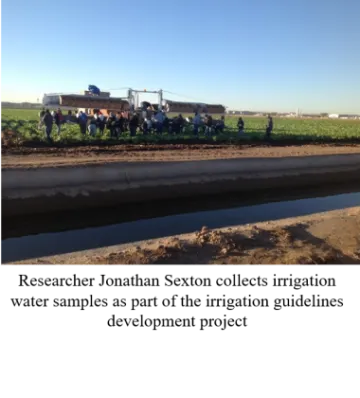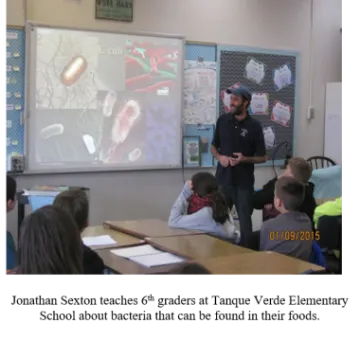In March of 2014, the largest Ebola outbreak in history began in West Africa, traveling shortly thereafter to the United States. While the outbreak remained largely on the East Coast, concern was heightened across the nation. Throughout the crisis—and as is true with many scares related to public health and the environment—there were, by and large, more questions than there were answers. “We no longer live in confined areas; with global transport, any disease or contaminant anywhere in the world is only a matter of hours from our state,” said Dr. Kelly Reynolds, director of the Environment, Exposure and Risk Assessment Center (ESRAC) at the University of Arizona.
One key to responding to outbreaks like Ebola, whether they occur within the state or thousands of miles away, is a team of experts prepared to answer questions and concerns with an awareness of the local environment. “In order to respond to issues within our state, we need people who are already familiar with the state—not just policies and practices, but even the geography in order to design the best research approaches,” Reynolds said. “We need to consider how we can work specifically with our environment because environmental contaminants behave differently in different environments.” A semi-arid border state with limited water supplies, Arizona presents a unique set of research demands. “We need a team of people who understand the dynamics of border populations and our water situation—our drought and growing population require that we’re creative about how we use and treat our water,” she said.
Finding answers to questions about the way environmental concerns effect public health requires the combined efforts of field monitoring and measurements paired with theoretical mathematical models; it requires the expertise of engineers and doctors, microbiologists and epidemiologists; it requires access to hospitals and fields, and the ability to communicate the findings to the public.
In March of 2014, ESRAC became an official center at the College of Public Health with the goal of bringing together industry sponsors, municipal governments and researchers from the colleges of Public Health, Agriculture and Life Sciences, Engineering, Medicine and Nursing to launch multi-faceted responses to issues related to public health and the environment.
“We have the expertise at the UA and the opportunity through ESRAC to pull teams together to answer these questions,” Reynolds said. “To be able to do these kind of projects, it took combined expertise that was not brought together before the TRIF initiative to fund ESRAC.”

The TRIF funding Reynolds referenced came in the form of a $250,000 seed grant, beginning in 2014 and dispersed over the span of three years. In those three short years, since Reynolds began pooling expertise from across campus under the umbrella of the center, ESRAC has leveraged the initial investment to the tune of $1.34 million with a staff of just three individuals. With the original TRIF funds, Reynolds brought aboard Dr. Jonathan Sexton—a microbiologist who worked under Reynolds for both his masters and PhD—to help run the center and manage the lab in the first year, and in the second hired post-doctoral researcher Dr. Marc Verhougstraete to help grow the center. Before joining the center, Verhougstraete had worked extensively on quantitative microbial risk assessments in the environment.
Together, the three brought industry partners to the table, expanded the expertise of ESRAC, and applied for a number of grants.
Responding to concerns related to things like the Ebola outbreak might be one of the more “romantic” projects ESRAC supports, but their work testing specific and often common interventions that are widely used, and that we ultimately know very little about, is another compelling initiative. Take gloves or face masks for example:
“There isn’t a lot of information about how effective these methods are,” Reynolds said. “Even though wearing gloves or a face mask is going to intuitively create a barrier and prevent exposure to contaminants, we have little information about how that translates into health effects,” Reynolds said. “We want to know more precisely what the effects of wearing a face mask during flu season [or other common interventions] are.”
In short, the research and interventions that ESRAC supports requires a village.
And ESRAC is a village, not confined to any one angle of intervention, but capable, rather, of responding to the complications of human health from a multitude of perspectives. Researchers under the ESRAC umbrella work with industry partners (like Clorox, Georgia Pacific, Kimberly Clark, and the Water Quality Association—to name a few) to develop new products, test the products, develop models for predicting the efficacy of the product, then come back and validate the model. Housing the capacity and expertise to take research full circle in this way is what Reynolds says draws an increasing number of industry sponsors to the table. ESRAC’s current project list boasts research initiatives related to everything from farm-to-table food safety, occupational health, and first responder and worker safety to air quality tests, economic impact analysis, and human health exposure modeling and risk assessment.
The Producer & the Consumer
One of Verhougstraete’s primary research initiatives is driven by a recent shift in the FDA Guidelines “Food Safety Modernization Act”, which requires farmers to perform more comprehensive testing of their irrigation water. Since historically growers have been provided for monitoring the quality of irrigation water used on their fields, Verhougstraete and team have defined best irrigation water monitoring guidelines for the southwest United States regions. These guidelines are being disseminated to growers throughout the region in bilingual, illustrated pamphlets. Verhougstrate and his team have collected more than 1,300 samples from Yuma, Imperial Valley, and Maricopa County, and are now in the process of doing molecular analysis on these samples to identify key viruses and pathogens that better predict microbial water quality and reduce human health risks.
Additional work fueled by the produce industry has Verhougstraete and team preparing to monitor microorganisms starting in canals and following them through irrigation systems and into fields to determine the relationship between water quality and the quality of soil and plants. The ultimate goal: providing farmers with a more efficient and accurate means of understanding water quality, while simultaneously reducing risks of food contamination stemming from impaired irrigation waters.
Start ‘em young
Aside from managing the ESRAC lab, Sexton is largely responsible for community outreach, a great deal of which relies on his own curriculum and includes everything from judging science fairs and one-on-one mentoring to giving lab tours to prospective students and standing in as the germ expert at the “Healthy to be Me” summer camp.
When Sexton is invited into a classroom, as he often is, he brings with him a set of experiments and lessons, but generally lets the students drive the discussion with their own concerns and interests. One activity he has a lot of success with goes something like this:

Sexton brings in a glow-in-the-dark powder that behaves likes germs. He starts by putting the germ-dust on one person’s hand, and then asks them to go around the room shaking the hands of their peers. Afterward, they turn off the light and, under a black light, examine the hands of the students to see how far and in what concentration the germs travelled. Similarly, Sexton applies the dust to a pencil and then has students sign in for class, or has them wash their hands and then reveals the leftovers.
If he plans on visiting the classroom multiple times, Sexton has students culture their fingers or swab the classroom to find out what the dirtiest thing in the room is.
“My students loved being grossed out,” said Lindsay Dauenhauer, a 2nd-grade teacher at Centennial Elementary in the Flowing Wells School District. Sexton has visited her class for the last eight years. “They learn that there are good germs and bad germs and how to stop the spread of bad germs: they sneeze into their elbows so their hands don’t touch everything, they started asking more to use the disinfecting spray and wipes around the classroom on things we frequently touch, and they are better hand washers.”
Aside from experiments, Sexton sees his time in the community as an opportunity for sharing ESRAC updates and activities.
“We have all these collaborations and people brought together through ESRAC, so when I go out to the public I can share what’s happening across a broad spectrum of research,” Sexton said, adding that it cultivates lasting interest in science and other STEM activities.
“The University plays such an important role in our community” said Dauenhauer. “I teach in a high poverty area and getting these kids to think about college is huge! A lot of research is happening at the UA and it is so awesome that they reach out to schools to share it.”
In addition to the trainings, workshops and lectures delivered to local K-12 schools, ESRAC has supported more than 46 graduate students, 27 undergraduates, 7 high school students, 6 post-doctoral students and 12 research staff.“Having the opportunity to train all the students we’ve been able to train is one of our primary goals,” Reynolds said. “We hope to get them interested in a variety of different projects and have them build skill sets specific to the environmental issues in our state and region— it grows a passion within the students to stay here, keep the skill set here, and grow the expertise within Arizona,” Reynolds.
And, while the center grows interest, expertise, and capacity within the state, they also set their sights well beyond political borders.
“We want to make sure that there’s recognition globally for what ESRAC can do. We can be leaders and innovators for some of the needs most critical in any part of the world. We have the expertise here to continue to grow and address issues not just within our state but across the globe."

